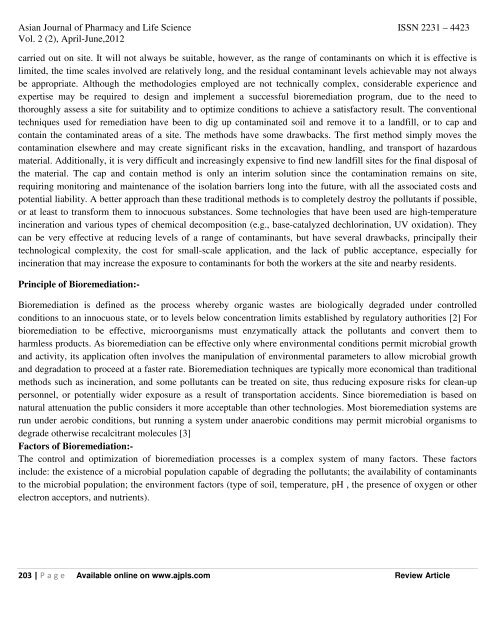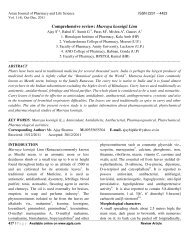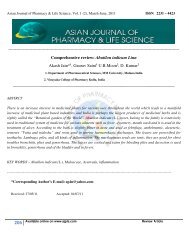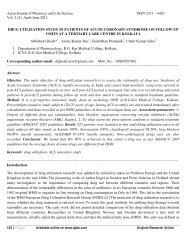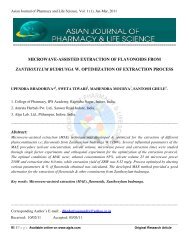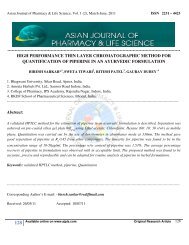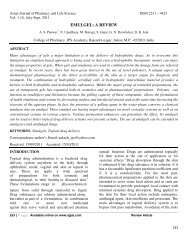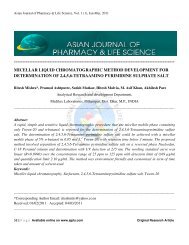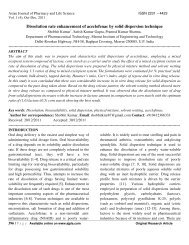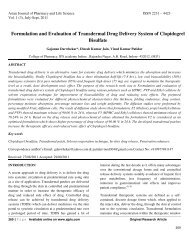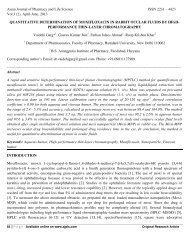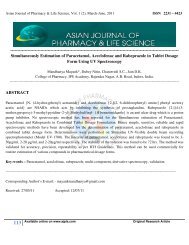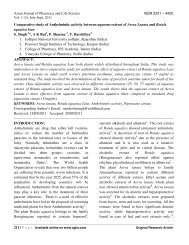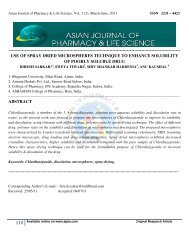Bioremediation - Asian Journal of Pharmacy and Life Science
Bioremediation - Asian Journal of Pharmacy and Life Science
Bioremediation - Asian Journal of Pharmacy and Life Science
Create successful ePaper yourself
Turn your PDF publications into a flip-book with our unique Google optimized e-Paper software.
<strong>Asian</strong> <strong>Journal</strong> <strong>of</strong> <strong>Pharmacy</strong> <strong>and</strong> <strong>Life</strong> <strong>Science</strong> ISSN 2231 – 4423Vol. 2 (2), April-June,2012carried out on site. It will not always be suitable, however, as the range <strong>of</strong> contaminants on which it is effective islimited, the time scales involved are relatively long, <strong>and</strong> the residual contaminant levels achievable may not alwaysbe appropriate. Although the methodologies employed are not technically complex, considerable experience <strong>and</strong>expertise may be required to design <strong>and</strong> implement a successful bioremediation program, due to the need tothoroughly assess a site for suitability <strong>and</strong> to optimize conditions to achieve a satisfactory result. The conventionaltechniques used for remediation have been to dig up contaminated soil <strong>and</strong> remove it to a l<strong>and</strong>fill, or to cap <strong>and</strong>contain the contaminated areas <strong>of</strong> a site. The methods have some drawbacks. The first method simply moves thecontamination elsewhere <strong>and</strong> may create significant risks in the excavation, h<strong>and</strong>ling, <strong>and</strong> transport <strong>of</strong> hazardousmaterial. Additionally, it is very difficult <strong>and</strong> increasingly expensive to find new l<strong>and</strong>fill sites for the final disposal <strong>of</strong>the material. The cap <strong>and</strong> contain method is only an interim solution since the contamination remains on site,requiring monitoring <strong>and</strong> maintenance <strong>of</strong> the isolation barriers long into the future, with all the associated costs <strong>and</strong>potential liability. A better approach than these traditional methods is to completely destroy the pollutants if possible,or at least to transform them to innocuous substances. Some technologies that have been used are high-temperatureincineration <strong>and</strong> various types <strong>of</strong> chemical decomposition (e.g., base-catalyzed dechlorination, UV oxidation). Theycan be very effective at reducing levels <strong>of</strong> a range <strong>of</strong> contaminants, but have several drawbacks, principally theirtechnological complexity, the cost for small-scale application, <strong>and</strong> the lack <strong>of</strong> public acceptance, especially forincineration that may increase the exposure to contaminants for both the workers at the site <strong>and</strong> nearby residents.Principle <strong>of</strong> <strong>Bioremediation</strong>:-<strong>Bioremediation</strong> is defined as the process whereby organic wastes are biologically degraded under controlledconditions to an innocuous state, or to levels below concentration limits established by regulatory authorities [2] Forbioremediation to be effective, microorganisms must enzymatically attack the pollutants <strong>and</strong> convert them toharmless products. As bioremediation can be effective only where environmental conditions permit microbial growth<strong>and</strong> activity, its application <strong>of</strong>ten involves the manipulation <strong>of</strong> environmental parameters to allow microbial growth<strong>and</strong> degradation to proceed at a faster rate. <strong>Bioremediation</strong> techniques are typically more economical than traditionalmethods such as incineration, <strong>and</strong> some pollutants can be treated on site, thus reducing exposure risks for clean-uppersonnel, or potentially wider exposure as a result <strong>of</strong> transportation accidents. Since bioremediation is based onnatural attenuation the public considers it more acceptable than other technologies. Most bioremediation systems arerun under aerobic conditions, but running a system under anaerobic conditions may permit microbial organisms todegrade otherwise recalcitrant molecules [3]Factors <strong>of</strong> <strong>Bioremediation</strong>:-The control <strong>and</strong> optimization <strong>of</strong> bioremediation processes is a complex system <strong>of</strong> many factors. These factorsinclude: the existence <strong>of</strong> a microbial population capable <strong>of</strong> degrading the pollutants; the availability <strong>of</strong> contaminantsto the microbial population; the environment factors (type <strong>of</strong> soil, temperature, pH , the presence <strong>of</strong> oxygen or otherelectron acceptors, <strong>and</strong> nutrients).203 | P a g e Available online on www.ajpls.com Review Article


